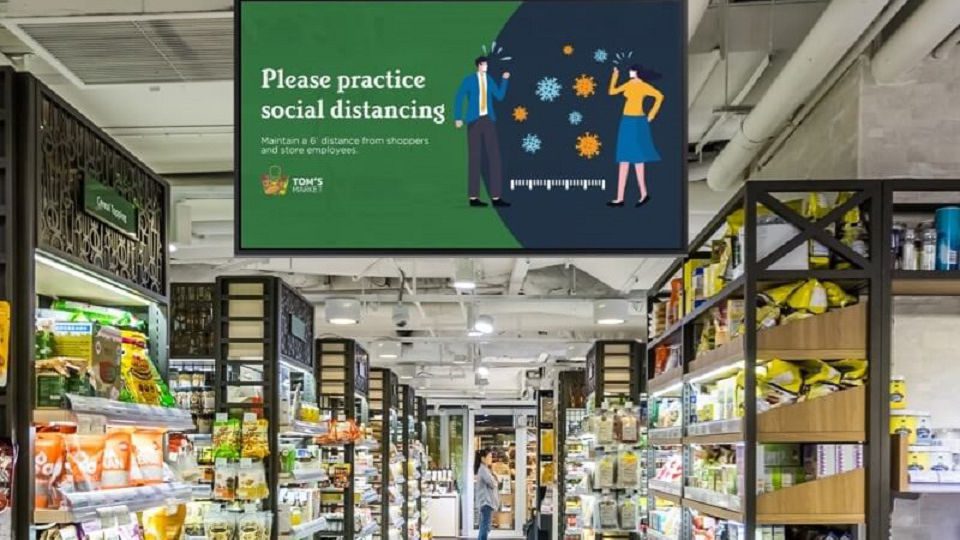 Customer experience has long been an important focus for retailers, but the way that experience is measured has changed amid COVID-19.
Customer experience has long been an important focus for retailers, but the way that experience is measured has changed amid COVID-19.
On-premise digital tools previously seen as enhancements have become mission-critical. Suddenly, retailers have customers who are as concerned about health and safety inside the store as they are about product selection and price.
Digital signage technology that was mainly used for driving sales promotions, generating foot traffic and delivering memorable experiences is now fundamental to day-to-day operations — both for global brands and for local businesses.
Screens are managing store access and lineups, reinforcing social distancing and communicating relevant changes, including stock levels and face mask policies. These screens are also minimizing staff-to-shopper contact and enabling new types of shopping, like mobile order-ahead and curbside pickup.
Changed Consumer Habits
Whether COVID-19 forced retail to change or accelerated changes that were already underway, shopping in 2020 looks a lot different than it did even a year ago. And at least some of these changes will outlast the health crisis.
The global consulting firm McKinsey, which has been gauging consumer sentiments in 2020, found that health concerns are now central to shopper attitudes and patterns. According to the report, “In addition to ecommerce, other digital and contactless services — including curbside pickup, delivery and drive-through service — are also seeing much higher adoption rates. While some of these habits are seen as a work-around to the crisis, many at-home solutions to regular activities will likely be adopted for the long-term.”
The firm’s surveys revealed that more than 60% of global consumers have changed their shopping behaviors in 2020. For U.S. consumers, it’s 75%.
The research also found that consumers have a heightened awareness of how retailers interact with them. Their choices of where to shop are now directly influenced by how companies take care of the safety of their employees.
Enabling Safe Shopping
Health concerns have reshaped retail in several ways:
- Monitoring and controlling access
- Enforcing social distancing and limiting one-on-one contact
- Creating a physical bridge between the online store and the physical store
- Enabling virtual and remote shopping experiences
Let’s break down how that’s playing out in stores of all types and descriptions.
Capacity Controls
Screens at entrances and in windows are being used to communicate store capacity and entry requirements like mandatory face coverings. These displays function as shopper traffic lights, metering entry based on occupancy. In some cases, sensor technology automates the capacity control screens — which can also be done manually, using tools as simple as a smartphone app.
Screens are also being used at entries to take temperature readings. Automated camera-based systems can look for shoppers with body temperatures that may be indicative of illness, and alert staff as needed.
Queue management technology — widely used in waiting rooms and checkout areas — has been adapted for use in stores. High-brightness window displays show people outside their waiting status, removing the need for a defined lineup. People can even wait in their cars. The screens notify them when they can come in — and double up with marketing messages.
In-Store Messaging
In-store screens serve multiple communication roles, reminding shoppers of mask requirements and distancing guidelines and keeping them apprised of changes.
Without digital display tools, many retailers have resorted to taping signs to their windows, columns, paper easels and whiteboards to communicate changes such as the availability of highly sought-after goods. Retailers already using digital signage technologies have been able to retain a professional look and change their messaging as often as needed.
Interactive touchscreens for product lookup, ordering and payment have reduced the need for one-on-one contact with staff. When hand sanitizer dispensers are nearby, touchscreens lower health risks by minimizing the need for face-to-face interactions with staff.
Bridging the Digital Divide
Order-ahead and store pickup have been trending in retail for some time; the emergence of COVID-19 just accelerated their adoption. Curbside pickup — with automated, click-and-collect lockers and bins or designated parking stalls — allows retailers to keep operating even if local mandates prevent in-store shopping. Outdoor-ready digital displays are central to making that work, driving awareness of pickup services, guiding shoppers on what to do and displaying notices on outdoor totems or window screens that update shoppers on their order status.
Virtual Experiences
The same web conferencing technologies that are facilitating remote meetings and connecting locked-down families is effective in retail as well. With interactive displays such as Samsung’s Flip 2 digital flipchart, a shopper can ask questions through a live videoconference on the store floor with a subject matter expert who may be time zones away. Shoppers get invaluable advice, and store operators deliver a great customer experience that doesn’t put staff at risk.
Thinking Ahead
Identifying the right technology solution for a retail operation requires addressing some considerations and dependencies. First, the solution should directly address a core problem, such as managing store access or staying on top of a fluctuating supply chain.
Second, the solution should be futureproofed. Technology that solves an immediate problem should also have a useful purpose in the future, as best as we can predict it. In-window displays, for example, which are now managing store access and curbside pickups, have effective long-term applications as shopper-facing marketing tools for generating foot traffic and boosting sales.
Parrish Chapman is a Director of Enterprise Sales within Samsung’s B2B Display Division, He has the honor of leading a team that focuses within Retail and E-SPORTS. He displays a strong commitment to building a high-performance team that maximizes human capital. Chapman is passionate about improving people, process, and technology while solving clients’ core business problems. Find out more about how the buyer’s journey is changing rapidly — both through safety mandates and digital transformation — in this free white paper. And discover how you can get back to business by optimizing technology.




